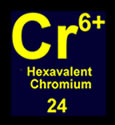Hexavalent Chromium
 Hexavalent chromium (CrVI) compounds exist in several forms. Industrial uses of hexavalent chromium compounds include chromate pigments in dyes, paints, inks, and plastics; chromates added as anticorrosive agents to paints, primers, and other surface coatings; and chromic acid electroplated onto metal parts to provide a decorative or protective coating. Hexavalent chromium can also be formed when performing "hot work" such as welding on stainless steel or melting chromium metal. In these situations the chromium is not originally hexavalent, but the high temperatures involved in the process result in oxidation that converts the chromium to a hexavalent state. Persistent skin irritation is also a problem that stems from trace amounts of hexavalent chromium in portland cements.
Hexavalent chromium (CrVI) compounds exist in several forms. Industrial uses of hexavalent chromium compounds include chromate pigments in dyes, paints, inks, and plastics; chromates added as anticorrosive agents to paints, primers, and other surface coatings; and chromic acid electroplated onto metal parts to provide a decorative or protective coating. Hexavalent chromium can also be formed when performing "hot work" such as welding on stainless steel or melting chromium metal. In these situations the chromium is not originally hexavalent, but the high temperatures involved in the process result in oxidation that converts the chromium to a hexavalent state. Persistent skin irritation is also a problem that stems from trace amounts of hexavalent chromium in portland cements.
Workers who breathe hexavalent chromium compounds at their jobs for many years may be at increased risk of developing lung cancer. Breathing high levels of hexavalent chromium can irritate or damage the nose, throat, and lungs. Irritation or damage to the eyes and skin can occur if hexavalent chromium contacts these organs in high concentrations or for a prolonged period of time.
The OSHA Permissible Exposure Limit (PEL) for hexavalent chromium is 5 µg/m³ TWA with an action level of 2.5 µg/m³.
For air sampling and analysis, the recommended method is ID-215, version 2.
Sampling for hexavalent chromium for most applications is very similar to sampling for lead. The main exception is that instead of a 37mm MCE cassette, you must use a 37mm PVC cassette. Otherwise, sample flow rates of 2 lpm for a personal sample, or up to 10 lpm for an area sample are acceptable.
Note that for certain types of sampling situations (specifically spray paint samples), an extended sample preparation process is required and will incur an additional cost for analysis.
SGS Forensic Laboratories has a reporting limit of 0.1 µg for air samples, so taking a minimum of 100 L will get you down to 1 µg/m³ as a reporting limit.
The analysis by OSHA method ID-215 is an ion chromatographic method with UV-VIS detection at 540-nm following post-column derivatization with 1,5-diphenyl carbazide. This method eliminates interferences with the traditional spectroscopy by separating out the Cr6+ from other interfering metals prior to the color development step. When interferences from other metals (primarily iron) is not suspected, the lower-cost UV-VIS method (NIOSH 7600) may be used.
Standard turn around time for this analysis is 5 working days, but faster times are usually able to be accommodated by the lab with advance notice. Note that hexavalent chromium has a hold time of only about 1 week, so timely delivery of the samples after collection is critical.
